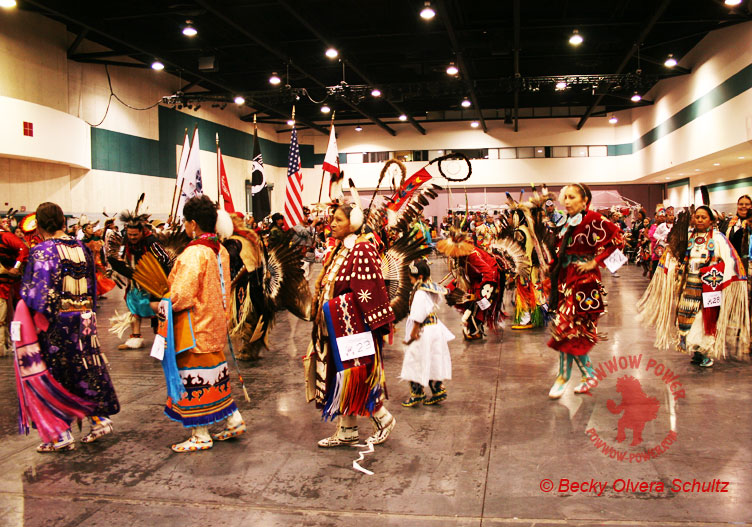Native American Female Dance Styles: Traditional, Fancy Shawl and Jingle
The Traditional women dancers, as opposed to the Traditional men, present a more regal style. They dance with their backs straight and heads held high. A Traditional woman dancer carries a long fringed shawl over one arm and in the other had holds an eagle feather fan. They take small, dipping steps that make the fringe on their gowns and shawl sway gently to the rhythm of the drum. Their dresses also reflect closeness to nature being made from animal skins and decorated with elk teeth, cowrie shells and porcupine quills (Ancona 1993:26-28). Beautiful intricate beadwork adorns their outfits. Their hair is usually worn in two braids, done in the French braid style. On the center back of the head is worn one or two beautiful eagle feathers attached with various hair ornaments, usually beaded. Many wear a single “breath” feather, a soft downy eagle feather. They wear leggings and deerskin moccasins that are decorated in beadwork (Braine 1995:21).
Fancy Shawl dancers are a style popular with girls and young women because it requires fast footwork, spins and leaps. Like the Fancy men dancers, the Fancy women dancers dazzle everyone with bright colors and shiny sequins and the long fringe of their shawls. The shawls are folded in half squarely and worn over the shoulders while their hands and arms hold out the ends spreading out the shawls, like a bird spreading its wings. Jumping and whirling and dancing around the arbor, the Fancy Shawl dancers look like flashes of bright butterfly wings (Ancona 1993:34). The Shawl dancers wear knee length dresses with matching leggings and moccasins. It is thought by some that this dance developed as the shawl replaced the blankets and animal robes worn by young women years ago. (Rendon 1996:32).
Jingle Dress dancers is also a younger woman’s dance since it requires a graceful style of hopping footwork with a zig zag path while dancing around the arbor. The hopping style causes the cones to jingle in time with the drum. The Jingle dancer carries an eagle feather fan in one hand while the other hand rest on her hip. The metal cones, made of rolled up tin tops from chewing tobacco cans, are sewed all around the dress in rows from top to bottom so they strike one another creating the tingling sound. According to one story, an Ojibwa shaman had a daughter that was very ill. He dreamed of a dress that had a shell hanging from it representing every day of the year. A voice told him in his dream that if his daughter danced in this dress, she would become well again. Upon awaking from his dream, he made the dress and asked his daughter to dance in it. She danced in the shell dress and become well. This dance nearly disappeared but had a revival among the young women who now make the jingles from the tin tops (Ancona 1993:40-41).




